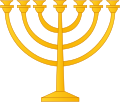
| Part of a series on |
| Islam |
|---|
 |
| Part of a series on |
| Judaism |
|---|
  |
| Islam and other religions |
|---|
| Abrahamic religions |
| Other religions |
| Islam and... |
| Others |
Religious ties between Muslims and the Jewish people have existed since the founding of Islam in the Arabian Peninsula in the 7th century; Muhammad's views on Jews were shaped by his extensive contact with the Jewish tribes of Arabia during his lifetime. Islam shares similar values, guidelines, and principles with the Jewish religion, and also incorporates Jewish history as a part of its own. [1] Muslims regard the Israelites, to whom Jews and Samaritans trace their ethnic ancestry, as an important religious concept; they are referenced around 43 times in the Quran, excluding individual prophets, [2] and in many accounts of hadith. Similarly, Moses, the most important Jewish prophet, is also regarded by Muslims as an Islamic prophet and messenger (see: Moses in Islam); [3] his name is mentioned in the Quran 136 times—more than any other individual—and his life is narrated and recounted more than that of any other prophet. [4] The Torah, which is the compilation of the first five books of the Hebrew Bible, is also held by Muslims as an Islamic holy book that was revealed by God (or Allah) through various Israelite prophets and messengers (see: Torah in Islam). Later rabbinic authorities and Jewish scholars, such as Maimonides, engaged in discussions concerning the relationship between Islam and Jewish religious law. Maimonides himself, it has been argued, was influenced by Islamic legal thought while living in the caliphates of his time. [5]
Contents
- Religious figures
- Abraham
- Moses
- Muhammad
- Other prophets
- Historical interaction
- Middle Ages
- Conversion of Jews to Islam
- Conversion of Muslims to Judaism
- Contemporary era
- Common aspects
- Holy scripture
- Religious law
- Rules of conduct
- Other similarities
- Interplay between Jewish and Islamic thought
- Saadia Gaon
- Maimonides
- Influence on exegesis
- Muslim–Jewish wars and military conflicts
- See also
- History
- Culture
- Issues
- Comparative religion
- Notes
- References
- Further reading
- External links
Although the origins of Judaism go back to the time of the ancient Hebrews, it is considered to have started becoming a distinct religion in its own right in the Kingdom of Judah, where it developed as a strictly monotheistic outgrowth of Yahwism. Thus, with a difference of at least 2,000 years, Judaism and Islam share a common geographical origin in what is known today as the Middle East, with the former from the Southern Levant and the latter from the Hejaz. Additionally, both religions claim Abraham as their spiritual patriarch and are thereby classified as Abrahamic religions. Islam was strongly influenced by Judaism in its fundamental religious outlook, structure, jurisprudence, and practice. [1] Because of this similarity, as well as through the influence of Islamic culture and philosophy on the Jewish populations in the Muslim world, there has been considerable and continued physical, theological, and political overlap between the two religions since Islam's founding. Notably, the first Islamic Waqf was donated by a Jew named Mukhayriq, who was a rabbi in the city of Medina. [6] In 1027, the Jewish polymath Samuel ibn Naghrillah became top advisor and military general of the Taifa of Granada in the Muslim-controlled Iberian Peninsula. [7] [8]
The Jewish people are among the three original "People of the Book" of Islam, which recognizes them, Christians, and Sabians as followers of the pre-Islamic revelations of Allah. Ties between the two communities have been marked by periods of cooperation, of ambivalence, and of open conflict. The early Muslims fought battles with a number of the Jewish tribes of Arabia, such as the Banu Qurayza, and Jews were persecuted at times under Muslim rule in subsequent centuries. Most recently, the Arab–Israeli conflict has resulted in heightened tensions between the Jewish world and the Muslim world, including the perpetuation of antisemitism and Islamophobia.






